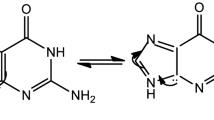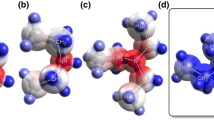Abstract
The stability of europium acetate complexes was examined potentiometrically at 25°C as a function of pressure in the range of 1–1000 bar. The measurements were carried out in an isothermal potentiometric cell with a liquid junction. The cell consisted of a pH glass electrode and an Ag, AgCl (3m KCl) reference electrode. The calibration of the cell on standard solutions has demonstrated that its electromotive force is independent of pressure. Based on pH measurements under various pressures in four acetate solutions with pH from 3 to 4.7 and containing 0.0142m Eu, we determined the standard partial mole volumes and the HKF parameters for the complexes Eu(Ac)2+ and Eu(Ac) +2 . The baric dependence of the Δf G 0 of the third complex, Eu(Ac) 03 , was evaluated from correlations. The stability of all three Eu acetate complexes decreased with pressure: as the pressure was increased from 1 to 1000 bar, the constants of formation of the complexes decreased by factors of 1.5–3 at 25°C and 2–6 at 170°C.
Similar content being viewed by others
References
R. I. Grauch, “Rare Earth Elements in Metamorphic Rocks,” in Geochemistry and Mineralogy of Rare Earth Elements, Ed. by B. R. Lipin and G. A. McKay (Mineral. Soc. Am., Washington, 1989), pp. 147–167.
J. Haas, E. L. Shock, and D. Sassani, “Rare Earth Elements in Hydrothermal Systems: Estimates of Standard Partial Molal Thermodynamic Properties of Aqueous Complexes of the REE at High Pressures and Temperatures,” Geochim. Cosmochim. Acta 59, 4329–4350 (1995).
S. A. Wood, “The Geochemistry of the Rare Earth Elements and Yttrium: 1. Review of Available Low-Temperature Data for Inorganic Complexes and the Inorganic Speciation of Natural Waters,” Chem. Geol. 82, 159–186 (1990).
E. L. Shock and C. M. Koretsky, “Metal-Organic Complexes in Geochemical Processes: Calculation of Standard Partial Molal Thermodynamic Properties of Aqueous Complexes at High Pressures and Temperatures,” Geochim. Cosmochim. Acta 57, 4899–4922 (1993).
S. A. Wood, “The Geochemistry of the Rare Earth Elements and Yttrium: 2. Theoretical Predictions of Speciation in Hydrothermal Solutions to 350°C at Saturation Water Pressure,” Chem. Geol. 88, 99–125 (1990).
E. L. Shock, “Organic Acids in Hydrothermal Solutions: Standard Molal Thermodynamic Properties of Carboxylic Acids and Estimates of Dissociation Constants at High Temperatures and Pressures,” Am. J. Sci. V, 496–580 (1995).
C. H. Gammons, S. A. Wood, and A. E. Williams-Jones, “The Aqueous Geochemistry of the Rare Earth Elements and Yttrium: VI. Stability of Neodymium Chloride Complexes from 25 to 300°C,” Geochim. Cosmochim. Acta 60, 4615–4630 (1996).
A. A. Migdisov, A. E. Williams-Jones, and O. M. Suleimenov, “Solubility of Chlorargyrite (AgCl) in Water Vapor at Elevated Temperatures and Pressures,” Geochim. Cosmochim. Acta 63, 3817–3827 (2002).
S. A. Wood, D. A. Palmer, D. J. Wesolowski, and P. Benezeth, “The Aqueous Geochemistry of the Rare Earth Elements and Yttrium: XI. The Solubility of Nd(OH)3 and Hydrolysis of Nd3+ from 30 to 290°C at Saturated Water Vapor Pressure with in-Situ pHm Measurements,” in Water-Rock Interactions, Ore Deposits, and Environmental Geochemistry: A Tribute to David A. Crear, Ed. by R. Hellmann and S. A. Wood, Geochem. Soc. Spec. Publ., No. 7, 229–256 (2002).
S. A. Wood, D. J. Wesolowski, and D. A. Palmer, “The Aqueous Geochemistry of the Rare Earth Elements: IX. A Potentiometric Study of Nd3+ Complexation with Acetate in 0.1 Molal NaCl Solution from 25 to 225°C,” Chem. Geol. 167, 231–253 (2000).
A. V. Zotov, B. R. Tagirov, I. I. Diakonov, and K. V. Ragnarsdottir, “A Potentiometric Study of Eu3+ Complexation with Acetate Ligand from 25 to 170°C at P sat,” Geochim. Cosmochim. Acta 66, 3599–3613 (2002).
A. Sonesson, “On the Chemistry of the Tervalent Rare Earth Ions: I. The Acetate Systems of Lanthanum, Cerium, Neodymium, and Gadolinium,” Acta Chem. Scand. 12, 165–181 (1958).
I. Grenthe, “On the Stability of the Acetate, Glycolate, and Thioglycolate Complexes of Tervalent Europium and Americium,” Acta Chem. Scand. 16, 1695–1712 (1962).
S. Deberdt, S. Castet, J.-L. Dandurand, et al., “Experimental Study of La(OH)3 and Gd(OH)3 Solubilities (25 to 150°C), and La-Acetate Complexing (25 to 80°C),” Chem. Geol. 151, 349–372 (1998).
P. A. Kryukov and S. A. Zarubina, “Determination of the pH of Some Reference Buffer Solutions under Pressures up to 1030 × 105 Pa and Temperatures from 0 to 25°C,” Izv. Sib. Otd. Akad. Nauk SSSR, Ser. Khim., No. 2, 56–66 (1982).
Yu. V. Shvarov, “Algorithmization of the Numeric Equilibrium Modeling of Dynamic Geochemical Processes,” Geokhimiya, No. 6, 646–652 (1999) [Geochem. Int. 37 (6), 571–576 (1999)].
Y. Shvarov and E. Bastrakov, A Software Package for Geochemical Equilibrium Modeling. User’s Guide (Australian Geological Survey Organization, Department of Industry, Science, and Resources, 1999).
Yu. V. Shvarov, UT-HEL: A Program for Calculation of the HKF Characteristics of Water Particles, Version 2 (Geol. Fak. Mosk. Gos. Univ., Moscow, 1995), unpublished [in Russian].
H. C. Helgeson, D. H. Kirkham, and G. C. Flowers, “Theoretical Prediction of the Thermodynamic Behavior of Aqueous Electrolytes at High Pressures and Temperatures: IV. Calculation of Activity Coefficients, Osmotic Coefficients, and Apparent Molal and Standard and Partial Molal Properties to 600°C and 5 kb,” Am. J. Sci. 281, 1249–1516 (1981).
J. M. Johnson, E. H. Oelkers, and H. C. Helgeson, “SUPCRT92: A Software Package for Calculating the Standard Molal Thermodynamic Properties of Minerals, Gases, Aqueous Species, and Reactions from 1 to 5000 bars and 0–1000°C,” Comput. Geosci. 18, 899–947 (1992).
E. L. Shock, D. A. Sassani, M. Wills, and D. A. Svervjensky, “Inorganic Species in Geologic Fluids: Correlations among Standard Molal Thermodynamic Properties of Aqueous Ions and Hydroxide Complexes,” Geochim. Cosmochim. Acta 61, 907–950 (1997).
E. L. Shock and H. C. Helgeson, “Calculation of the Thermodynamic and Transport Properties of Aqueous Species at High Pressures and Temperatures: Correlations Algorithms for Ionic Species,” Geochim. Cosmochim. Acta 52, 2009–2036 (1988).
J. K. Hovey, Ph. D. Thesis (Univ. Albertta, Edmonton, 1988).
J. C. Tanger and H. C. Helgeson, “Calculation of the Thermodynamic and Transport Properties of Aqueous Species at High Pressures and Temperatures: Revised Equations of State for the Standard Partial Molal Properties of Ions and Electrolytes,” Am. J. Sci. 288, 19–98 (1988).
Author information
Authors and Affiliations
Additional information
Original Russian Text © A.V. Zotov, L.A. Koroleva, E.G. Osadchii, 2006, published in Geokhimiya, 2006, No. 4, pp. 426–436.
Rights and permissions
About this article
Cite this article
Zotov, A.V., Koroleva, L.A. & Osadchii, E.G. Potentiometric study of the stability of Eu3+ acetate complexes as a function of pressure (1–1000 bar) at 25°C. Geochem. Int. 44, 384–394 (2006). https://doi.org/10.1134/S0016702906040057
Received:
Issue Date:
DOI: https://doi.org/10.1134/S0016702906040057




